Czichos H., Saito T., Smith L.E. (Eds.) Handbook of Metrology and Testing
Подождите немного. Документ загружается.


858 Part D Materials Performance Testing
Table 15.4 Analytical techniques allowing the investigation of bulk changes
Acronym Meaning Principle/assessed property References
Optical transmission
spectroscopy (IR,
Vis, UV)
Species are identified by the frequencies and structures of ab-
sorption, emission, or scattering features, and quantified by the
intensities of these features. Enable trace analysis of organic
additives such as heat and UV stabilizers, flame retardants,
slip and deforming agents, solvent or monomeric or oligomeric
residues, softeners
[15.66]
Thermo-analytical
techniques
Investigate a physical property of the sample as a function of
a controlled temperature program. Increased analytical value
by coupling to infrared or mass spectrometers, for instance
TG-FTIR of TG-MS
[15.67]
AAS Atomic absorption
spectrometry
Atomized either by flame or electrothermally; AAS is charac-
terized by selective resonance absorption of neutral atoms of
the light of monochromatic light, proportional to its concentra-
tion
[15.68]
XFA X-ray fluorescence
analysis
Emission and detection of characteristic x-ray radiation
of atoms after excitation by means of high-energy γ -ray
Bremsstrahlung.
Allows multi-element analysis.
Semiquantitative analysis of inorganic components in poly-
mers
[15.61]
ICP-MS Inductively coupled
plasma mass
spectrometry
Ionization of a sample and separation of the ions in a mass
spectrometer.
Allows multi-element analysis. Remarkably lower detection
limits (ppt range) than AAS. Only low concentration solutions
usable
[15.69]
GPC Gel permeation
chromatography
The molar mass of polymers dissolvable in GPC solvents (most
commonly tetrahydrofuran or chloroform) can be determined
as retention time in chromatographic columns that work ac-
cording to the size exclusion principle. Requires calibration of
molar mass as function of retention time. Gives the complete
molecular-weight distribution curve
[15.70]
CL Chemiluminescence Weak photon emission in first approach linear to reaction
rate of oxidation reaction detected by for instance pho-
tomultipliers. Very sensitive means to follow oxidative ageing
kinetics of polymers. Depending on transmission properties of
the sample surface biased. No direct information on emitting
species
[15.71–73]
Spot Analysis of Polymer Surfaces. The aforementioned
spatial heterogeneous reaction of most interactions
between polymeric materials and the environment im-
plies the necessity for imaging microscopic techniques.
These allow a distinctive analysis of spots within the
bulk as well as the surface to be done.
Polymer Bulk Detection Techniques.
Changes in the Composition (Polymer-Copolymer-
Additives-Fillers). The techniques listed under this
topic also look at bulk properties but particularly al-
low conclusions to be drawn about the composition of
a multicomponent system.
Limits of Lifetime Predictions. For lifetime predic-
tions many industrial areas have already made the
transition from strong dependence on long-term prac-
tical tests to strong reliance on short-term laboratory
test results. In these cases the lifetime of the ma-
terial mostly depends on the impact of only one or
two, often relatively constant, exposure parameters,
e.g. the temperature, that dominate the limitation of
lifetime.
For polymeric materials exposed to natural weather-
ing conditions lifetime predictions based on laboratory
tests are much more complex. The results of property
changes of polymeric materials as a consequence of
Part D 15.1

Material–Environment Interactions 15.1 Materials and the Environment 859
Table 15.5 Techniques particularly suited to determine changes in composition
Acronym Meaning Principle/assessed property References
NMR Nuclear magnetic
resonance
Resonance interaction between the nuclear spins of, for in-
stance,
1
Hor
13
C atoms of the sample, which is placed in
a homogenous external magnetic field, with high-frequency
radio waves.
Allows analysis of composition and structural changes, such
as chain branching and stereochemical configuration. NMR is
not sensitive enough for minor components
[15.74,75]
IR IR/Raman
spectroscopy
Vibrational spectra allow qualitative and quantitative analysis
of functional groups (kind and concentration) and render infor-
mation on the constitution. Carbonyl bands can give measure
for oxidative ageing
[15.76]
UV/Vis UV/Vis micro-
spectrophotometry
For depth profiling, typically microtome cross-section slices of
the sample are investigated in transmission mode. Allows the
detection of the formation or disappearance of chromophoric
groups, such as degradation products of the polymer as well as
additives
[15.77]
ESCA Electron spectros-
copy for chemical
analysis
For the principles see Table 15.3. Applicable for depth profil-
ing in combination with sputtering
Sect. 6.1.2
SIMS Secondary-ion mass
spectrometry
For principles see Table 15.3. Applicable for depth profiling
in combination with sputtering
Sect. 6.1.3
Pyrolysis-MS Pyrolysis mass
spectrometry
A sample is pyrolized using heat, and the fractions are ana-
lyzed by a mass spectrometer to which the pyrolysis cell is
coupled
[15.78]
accelerated artificial and long-term outdoor exposures
may depend on
1. the specific material under test (e.g. polymer type,
formulation, dimensions, processing conditions, the
age and the initial moisture content of the test spec-
imen at the start of exposure),
2. the exposure conditions (e.g. mean and maxima of
the UV irradiance, temperature, relative humidity
and time of wetness, acidic or biological attack, the
season when outdoor exposure is started and when
it is terminated), and
3. the type of analytical determination and evaluation
of the property changes (e.g. physical or chemical
properties, surface- or bulk-influenced properties).
This means that lifetime prediction for polymeric
materials needs a lot of information on the ageing
behavior of the material under consideration, on the
artificial and outdoor exposure conditions and on the
determination of relevant material properties. These re-
quirements mean that lifetime prediction remains an art
rather than a science.
For several decades, scientists had a fundamental
knowledge of the weathering performance of the differ-
ent types of polymeric material in use. Developments of
new formulations or techniques mostly did not dramati-
cally decrease or increase their performance. Because of
a lack of confidence in results from artificial accelerated
tests the different lifetimes of these new polymeric ma-
terials were, estimated by comparative artificial or/and
short-time outdoor exposure tests.
During this period, the normally applied procedure
of lifetime prediction consisted in simply comparing
the radiant exposures from artificial tests with the ex-
pected radiant exposures in the field of application.
There was no consideration of the influence e.g. of
different spectral distributions of irradiance, tempera-
tures, relative humidities and cycles of wet and dry
periods. And, even now, we have no confirmation that
the reciprocity law is generally valid for the different
irradiance levels applied in natural and laboratory expo-
sure tests [15.79, 80]. Only over the last two decades,
the lack of confidence in results from artificial acceler-
ated tests is decreasing and knowledge on the influence
of different climatic quantities and other weather factors
is continually growing.
Today, the rapid progress of developing new poly-
meric materials with clearly changed formulations and
additives that meet the demands of new processing
technologies and environmental restrictions, e.g. the
Part D 15.1

860 Part D Materials Performance Testing
reduction of volatile organic compounds and waste dis-
posal, does not allow sufficient durability testing by
outdoor exposure. For the lifetime of their products,
the producing and processing industries have to rely on
data determined by accelerated exposure tests and on
lifetime predictions on the basis of these data.
Therefore, there is an increasing activity of research
on different methods of lifetime prediction based on
reliable laboratory tests [15.25].
Key factors in further research of lifetime prediction
estimates for a given polymeric material are
1. understanding actual in-service conditions and its
variability,
2. understanding the influence of the variety of actions
caused by outdoor exposure, and
3. confidence in results from laboratory tests at con-
trolled exposure conditions.
15.2 Emissions from Materials
15.2.1 General
Emissions from materials influence the surrounding en-
vironment. Gaseous emissions – mainly volatile organic
compounds (VOCs) – into indoor air are of special
interest due to the fact that they affect indoor air qual-
ity (IAQ). VOCs are of importance because they are
strongly related to the so-called sick-building syndrome
(SBS). Materials are not the only source of indoor air
pollution. Other important sources are every type of
combustion (e.g. fire places, gas cooking), especially
smoking (environmental tobacco smoke (ETS)) and
the use of household chemicals (sprays, solvents e.g.).
Whereas these kinds of sources can be influenced by the
user (to use or not to use it) materials emissions can-
not be influenced by the user to the same extent. Often
the user is simply not aware that materials might have
emissions.
To reduce emissions from materials, first of all
knowledge is needed about
1. what is contained in the material,
2. what is emitted (quality),
3. how much is emitted (quantity),
4. duration of the emissions (time behavior, ageing).
In addition to these material parameters envi-
ronmental parameters such as temperature, relative
Table 15.6 Classification of organic indoor pollutants according to their volatility
Description Abbreviation Boiling point range
∗
(
◦
C)
Very volatile (gaseous) organic compounds VVOC < 0to50–100
Volatile organic compounds VOC 50–100 to 240–260
Semivolatile organic compounds SVOC 240–260 to 380–400
Organic compounds associated with particulate matter or par-
ticulate organic matter
POM > 380
∗
Polar compounds are at the higher end of the range
humidity, and air exchange rate influence the emissions
or the resulting concentration in air.
To measure materials emissions, emission test
chambers are used, which simulate environmental con-
ditions such as those mentioned above. Air sampling
and analysis is an essential part of emission testing.
15.2.2 Types of Emissions
Emissions from materials can be divided into classes of
volatility and product classes depending on their field of
application.
Classes of Volatility
According to [15.81,82] volatile organic compounds are
divided into very volatile organic compounds (VVOCs),
VOCs, semi-volatile organic compounds (SVOCs) and
particulate organic matter/organic compounds associ-
ated with particulate organic matter (POM)(Table15.6)
depending on their volatility.
An important sum parameter for VOCsistheso-
called total volatile organic compounds (TVOCs) value.
According to ISO 16000-6, the TVOC is defined as sum
of volatile organic compounds sampled on Tenax TA
and eluting between and including n-hexane and n-
hexadecane in a nonpolar gas-chromatography (GC)
column.
Part D 15.2

Material–Environment Interactions 15.2 Emissions from Materials 861
Product Classes
Depending on the material and its intended field of use
many chemicals are contained that might be released
during the use of the material. Some examples of ma-
terials relevant to indoor use are listed here
1. lacquer, paints, coatings,
2. wood, wood-based materials,
3. furniture,
4. construction products,
5. insulating materials,
6. sealants,
7. adhesives,
8. flooring materials,
9. wall papers,
10. electronic devices,
11. printed circuit boards.
Even in the simple case of e.g. a single polymer
it can still contain remaining monomers or solvents
and additives from the production that can generally be
emitted. Additionally special types of polymers like e.g.
polycondensated resins (e.g. urea-formaldehyde resins)
can be hydrolyzed and release monomers. Furthermore
materials can contain a wide spectrum of additives like,
e.g.
1. plasticisers,
2. biocides (e.g. from production, pot preservatives,
film preservatives),
3. flame retardants,
4. photoinitiators,
5. stabilizers.
15.2.3 Influences
on the Emission Behavior
The emission behavior of materials is influenced by ma-
terial and environmental parameters.
Material Parameters
The following material parameters are of importance for
emission behavior
1. type of material,
2. ingredients,
3. structure,
4. composition,
5. surface,
6. age.
According to [15.83] the rate of emission of organic
vapors from indoor materials is controlled by three fun-
damental processes: evaporative mass transfer from the
surface of the material to the overlaying air, desorp-
tion of adsorbed compounds, and diffusion within the
material.
Environmental Parameters
The following environmental parameters influence
emission behavior
1. temperature (T),
2. relative humidity (RH),
3. air exchange rate (n),
4. area specific ventilation rate (q),
5. air velocity.
According to [15.83] temperature affects the vapor
pressure, desorption rate, and the diffusion coefficients
of the organic compounds. Thus, temperature affects
both the mass transfer from the surface (whether by
evaporation or desorption) and the diffusion mass trans-
fer within the material. Increases in temperature cause
increases in the emissions – as can be seen in Fig. 15.14
as an example – due to all three mass-transfer processes
mentioned above.
The air exchange rate is another important parame-
ter that affects the concentration of organic compounds
in indoor air. The air exchange rate is defined as the flow
of outdoor air entering the indoor environment divided
by the volume of the indoor space, usually expressed
in units of h
−1
. The higher the air exchange rate the
greater the dilution, assuming that the outdoor air is
cleaner, and the lower the concentration (see Fig. 15.15
for example).
Factor for change of concentration F
C
3.5
3
2.5
2
1.5
1
0.5
0
17 18 19 20 21 22 23 24 25 26 27 28 29
Temperature T (°C)
Benzophenone
n-Butylacetate
F
C
= 0.35383exp[(T–18.11193)/4.86055]
F
C
=0.11T–1.50
Fig. 15.14 Influence of temperature on the concentration
(here the factor for the change of concentration) for a VOC
and a SVOC emitted from a UV-curing acrylic lacquer
applied to wood
Part D 15.2
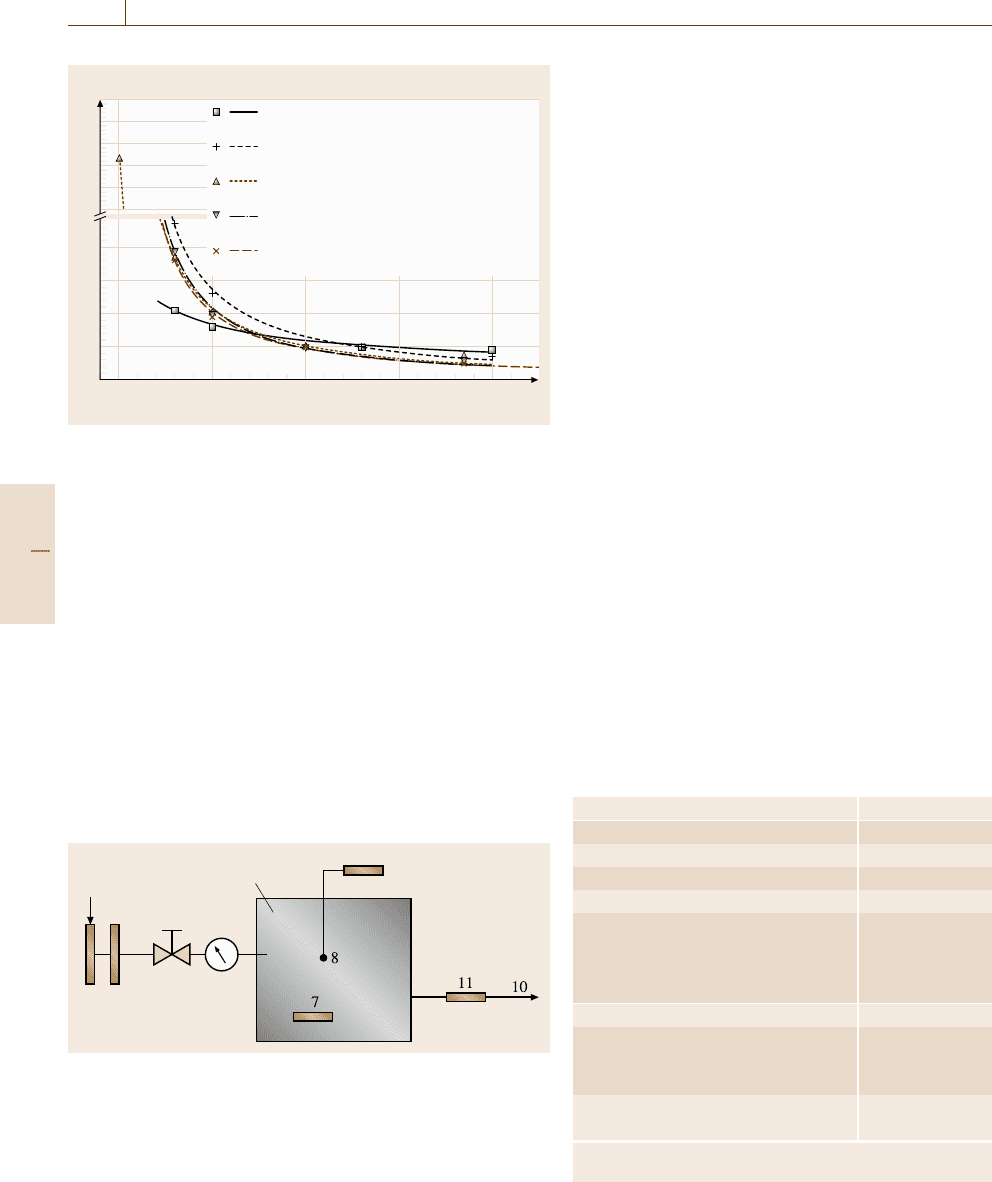
862 Part D Materials Performance Testing
Factor for change of concentration F
C
20
19
18
17
16
15
4
3
2
1
0
0 0.5 1 1.5 2
Air exchange rate n
Benzophenone, UV lacquer
F
C
= 5.08/(1 +3.24546 n
0.65372
)
Ethylacetate, PU lacquer
F
C
= 17.3/(1 +16.06777 n
1.20182
)
Butylacetate, UV lacquer
F
C
= 51.7/(1 +39.17365 n
1.12189
)
Methylisobutyketone, PU lacquer
F
C
= 42.5/(1 +43.23184 n
1.20764
)
Methoxypropylacetate, PU lacquer
F
C
= 0.92515 n
–1.11968
F
C1.5/0.3
= 2.1
F
C1.5/0.3
= 5.6
F
C1.5/0.3
= 5.7
F
C1.5/0.3
= 6.4
F
C1.5/0.3
= 6.1
Fig. 15.15 Influence of the air exchange rate on the concentration
(here the factor for the change of concentration) for some VOCs
emitted from different lacquers (polyurethane (PU) lacquer, UV-
curing acrylic lacquer) both applied to wood
Variation of the air exchange rate by a factor of
5(Fig.15.15: F
C1.5/0.3
(n = 1.5h
−1
/0.3h
−1
)) results
in a change of concentration (F
C
) of 5.6 to 6.4 with
the exception of benzophenone. For benzophenone the
concentration changes only by a factor 2.1, which
is assumed to be due to adsorption effects of this
SVOC.
15.2.4 Emission Test Chambers
Emission test chambers are necessary to provide defined
environmental conditions for the evaluation of mater-
1
2
3
4
5
6
9
Fig. 15.16 General description of an emission test chamber (1: air
inlet, 2: air filter, 3: air-conditioning unit, 4: air flow regulator, 5: air
flow meter, 6: test chamber, 7: device to circulate air and control air
velocity, 8: temperature, humidity, and air velocity sensors, 9: mon-
itoring system for temperature and humidity, 10: exhaust outlet,
11: manifold for air sampling)
ials emissions. In addition to those mentioned above the
following criteria have to be met
1. clean air supply,
2. emission-free or low-emission chamber materials
(stainless steel or glass, low-emission sealings),
3. sufficient mixing of the chamber air,
4. tightness of the chamber,
5. low adsorption on chamber walls,
6. easy cleaning of the chamber after tests.
In Europe and meanwhile international a distinc-
tion is made between emission test chambers (EN
ISO 16000-9 [15.84]) and emission test cells (EN
ISO 16000-10 [15.85]). Furthermore EN ISO 16000-
11 [15.86] exists, describing sampling and storing of
material samples and the preparation of test specimen.
It should be mentioned that these standards are made
for the testing of building products, but the emission
test chambers and, in the case of planar products, also
the emission test cells are applicable for other kinds of
materials. The chamber/cell parameters are listed in Ta-
ble 15.7.
In Fig. 15.16 a general description of an emission
test chamber according to EN ISO 16000-9 is shown.
In Fig. 15.17 an example of an emission test cell accord-
ing to EN ISO 16000-10 can be seen.
In the USA small emission test chambers are de-
scribed in [15.83]. According to this standard small
chambers have volumes between a few liters and 5 m
3
.
Chambers with volumes of more than 5 m
3
are regarded
as large chambers.
Table 15.7 Specifications for emission test chambers/cells
Vo l u m e ( V) Not specified
Temperature (T) 23±2
◦
C
Relative humidity (RH) 50±5%RH
Air exchange rate (n) See q
Product loading factor (L) See q
Area specific air flow rate (q = n/L)
Flooring materials 1.3m
3
m
−2
h
−1
Wall materials 0.4m
3
m
−2
h
−1
Sealing materials 44 m
3
m
−2
h
−1
Air velocity at the sample surface 0.1–0.3ms
−1 ∗
Background concentration
Single VOC 2 μg/m
3
TVOC 20 μg/m
3
Minimum standard air sampling times 72 ±2h
(duplicate sampling)
28 ±2d
∗
only for EN ISO 16000-9,
not mandatory for EN ISO 16000-10
Part D 15.2
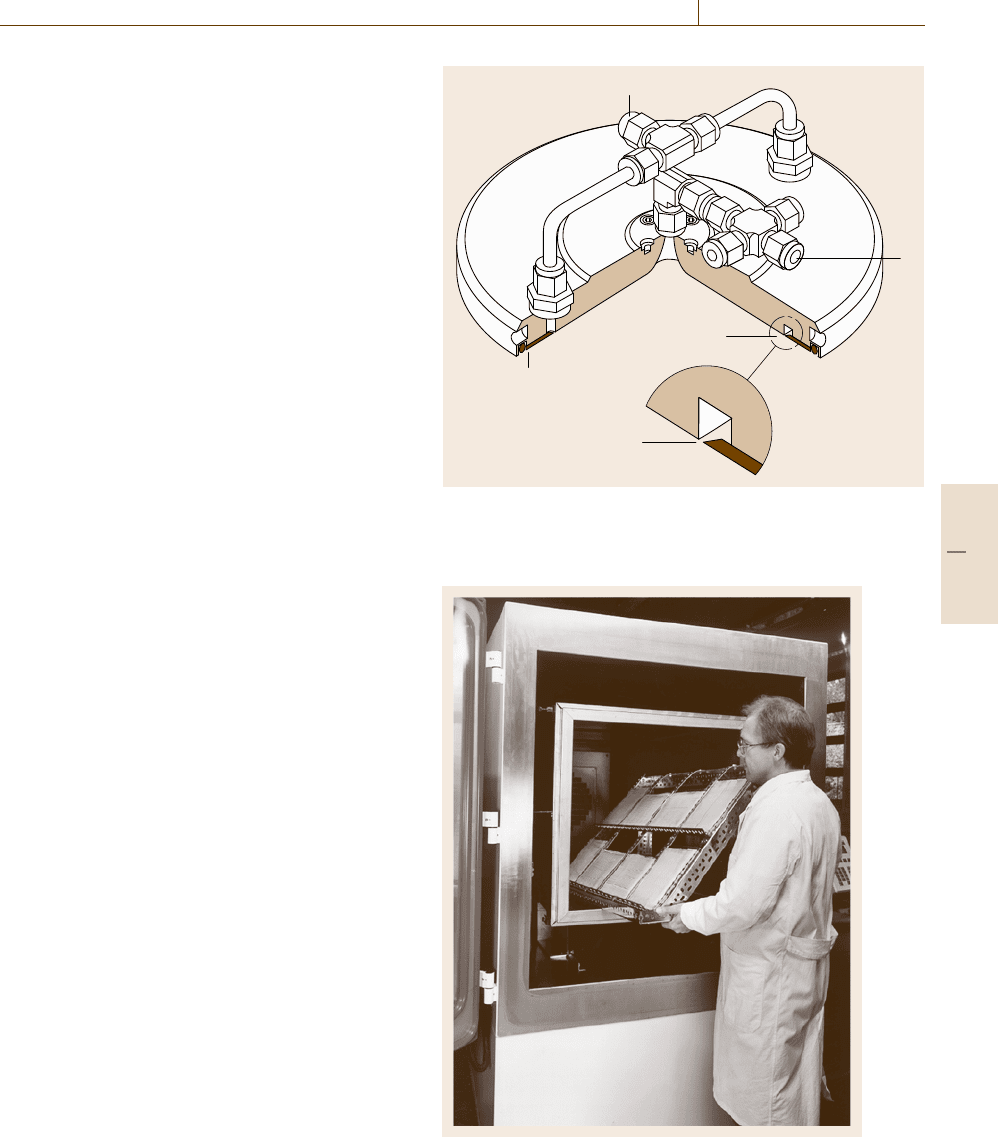
Material–Environment Interactions 15.2 Emissions from Materials 863
For Japan small emission test chambers are de-
scribed in [15.87]. Small chambers in this standard are
defined to have volumes between 20 l and 1 m
3
. The test
temperature is 28±1
◦
C, differing from EN ISO 16000-
9 and 16000-10 where it is fixed to 23 ±2
◦
C.
In Europe as well as in the USA additional stan-
dards for the testing of formaldehyde emissions and
emissions from wood-based materials exist. These
are EN 717-1 [15.88], ASTM D 6007-02 [15.89],
ASTM D 6330-98 [15.90]andASTM E 1333-
10 [15.91].
In Fig. 15.18 a1m
3
chamber is shown loaded
with an adhesive applied to glass plates for emission
testing. The test specimen is brought into the cen-
ter of the chamber where the air velocity is adjusted
to 0.1–0.3m/s. Before loading of the chamber the
background concentration has been proven to be be-
low the limits described in Table 15.7. The chamber
shown [15.92] allows cleaning by thermal desorption at
temperatures of up to 240–260
◦
C in combination with
a purging with clean dry air of up to four air exchanges
per hour.
In Fig. 15.19 a 20 l chamber is shown also loaded
with an adhesive applied onto glass plates. The con-
ditions of temperature, relative humidity, area specific
ventilation rate, air velocity, and clean air supply are the
same as for the 1 m
3
chamber shown in Fig. 15.18.
In Fig. 15.20 a photograph of a FLEC is shown.
The test conditions are the same as described above.
Therefore even the FLEC with a volume of only 35 ml
allows emission rates comparable to the emission test
chambers as long as planar homogenous materials are
investigated with a smooth surface where emission from
small edges plays no major role.
Larger chambers with volumes of more than
1m
3
[15.87], 5 m
3
[15.83], or 12 m
3
[15.88] might
be useful if complex products like e.g. machines (e.g.
printers, copiers) have to be tested for emissions. Emis-
sions from hard-copy devices (TVOC, styrene, benzene,
ozone and dust) can also be measured [15.93]. This test
method has been published for measurements according
to the German Blue Angel mark [15.94] and is based on
the international standards for emission test chambers
EN ISO 16000-9 and ISO 16000-6 for air sampling and
analysis, see Sects. 15.2.5 and 15.2.6.
15.2.5 Air Sampling
from Emission Test Chambers
The appropriate air sampling method depends on
what has to be measured. The most common method
1
2
3
4
5
Fig. 15.17 Description of an example of an emission test cell: gen-
eral description in three dimensions of the field and laboratory
emission cell (1: air inlet, 2: air outlet, 3: channel, 4: sealing ma-
terial, 5: slit)
Fig. 15.18 1m
3
emission test chamber loaded for a test
with a flooring adhesive on glass plates (courtesy of BAM)
Part D 15.2
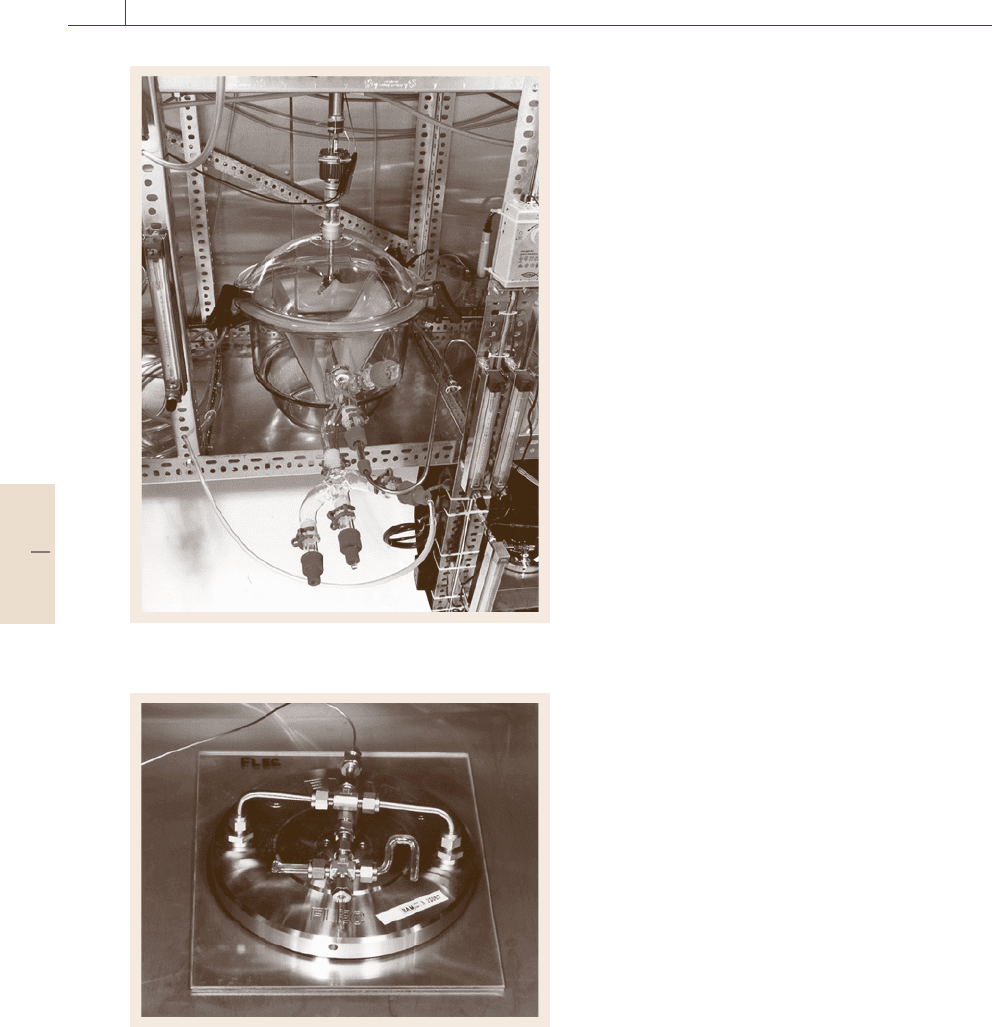
864 Part D Materials Performance Testing
Fig. 15.19 20 l m
3
emission test chamber – loaded with
a flooring adhesive on glass plates (courtesy of BAM)
Fig. 15.20 Field and laboratory emission cell (FLEC) ac-
cording to EN ISO 16000-10) (courtesy of BAM)
for VOC is sampling on Tenax (polyphenylenox-
ide, based on 2,6-diphenylphenol) as absorbance for
enrichment according to ISO 16000-6 [15.95]and
ISO 16017 [15.96] followed by thermal desorption
and analysis with gas-chromatography mass spec-
trometry (GC/MS, see Sect. 15.2.6). Another method
being of increasing importance is sampling on 2,4-
dinitrophenylhydrazine (DNPH) cartridges according to
ISO 16000-3 [15.97] followed by solvent desorption
(acetonitrile) and analysis by high-performance liquid
chromatography (HPLC) using a diode-array detector
(DAD)orUV detection (Sect. 15.2.6).
For sampling of VVOCs from air a wide spectrum
of method exists that strongly depend on what has to be
measured.
SVOCs can either be sampled by Tenax up to boil-
ing points of about 360
◦
C(n-C
22
-alkane) [15.98]or,
for higher boiling SVOCs, by special polyurethane
foam (PUF) [15.99, 100] with subsequent solvent ex-
traction. The sampling of SVOCsonPUF has been
practiced successful for biocides [15.101]andflame
retardants [15.102].
Table 15.8 gives an overview on sorbents for
sampling of volatile organic compounds belonging to
different ranges of volatility.
Figure 15.21 shows examples of sorbent tubes
used for sampling of volatile organic compounds from
(chamber) air.
15.2.6 Identification and Quantification
of Emissions
The most common method for the identification and
quantification of volatile organic compounds from air
is gas chromatography with subsequent mass spec-
trometry (GC/MS). Using GC (Sect. 1.2) the substance
mixtures are separated into the single compounds and,
by MS (Sect. 2.1), the mass spectra are generated. Mass
spectra can often be used successful for library searches
to obtain initial information on the identity of sub-
stances. For the confirmation of identity, calibration,
and quantification, authentic standards has to be used.
High-performance liquid chromatography with either
diode-array detectors (HPLC/DAD)orUV detectors
(HPLC/UV) (Sects. 1.2 and 2.2) is used for substances
for which GC is not suitable, e.g. for substances that are
thermally unstable.
Figure 15.22 shows a chromatogram resulting from
a chamber test of PVC flooring, air sampled with Tenax
TA followed by thermal desorption and GC/MS analy-
sis.
In Table 15.9 the substances are listed with their
concentration on different days over the testing time of
Part D 15.2

Material–Environment Interactions 15.2 Emissions from Materials 865
Table 15.8 Guidelines for sorbent selection (after [15.103, 104])
Sample tube Approx. analyte Maximum, Specific sur- Example analytes
sorbent volatility range Temperature face area
(
◦
C) (m
2
/g)
CarbotrapC (n-C
8
to n-C
20
) > 400 12 Alkyl benzenes and aliphatics ranging in volatility
CarbopackC from n-C
8
to n-C
16
Anasorb GCB2
Tenax TA bp 100–400
◦
C 350 35 Aromatics except benzene, apolar components
(n-C
7
to n-C
26
) (bp > 100
◦
C) and less-volatile polar components
(bp > 150
◦
C)
TenaxGR bp 100–450
◦
C 350 35 Alkyl benzenes, vapor-phase PAHsandPCBsand
(n-C
7
to n-C
26
) as above for Tenax TA
Carbotrap (n-C
4
/C
5
to n-C
14
) > 400 100 Wide range of VOCs incl., ketones, alcohols,
CarbopackB and aldehydes (bp > 75
◦
C) and all apolar compounds
Anasorb within the volatility range specified.
GCB1 (n-C
4
) Plus perfluorocarbon tracer gases
Chromosorb 102 bp 50–200
◦
C 250 350 Suits a wide range of VOCs incl. oxygenated
compounds and haloforms less volatile than
methylene chloride
Chromosorb 106 bp 50–200
◦
C 250 750 Suits a wide range of VOCs incl. hydrocarbons
from n-C
5
to n-C
12
. Also good for volatile oxygenated
compounds
Porapak Q bp 50–200
◦
C 250 550 Suits a wide range of VOCs including oxygenated
(n-C
5
to n-C
12
) compounds
Porapak N bp 50–150
◦
C 180 300 Specifically selected for volatile nitriles; acrylonitrile,
(n-C
5
to n-C
8
) acetonitrile and propionitrile. Also good for pyridine,
volatile alcohols from EtOH, MEK, etc.
Spherocarb
∗
−30–150
◦
C > 400 1200 Good for very volatile compounds such as VCM,
(C
3
to n-C
8
) ethylene oxide. CS
2
and CH
2
Cl
2
. Also good for volatile
polars e.g. MeOH, EtOH and acetone
Carbosieve SIII
∗
−60–80
◦
C 400 800 Good for ultra-volatile compounds such as C
3
and C
4
Carboxen 1000
∗
hydrocarbons, volatile haloforms and freons
Anasorb CMS
∗
Zeolite −60–80
◦
C 350 Used specifically for 1,3-butadiene and nitrous oxide
Molecular Sieve
13X
∗∗
Coconut Charcoal
∗
−80–50
◦
C > 400 > 1000 Rarely used for thermal desorption because
(rarely used) metal content may catalyze analyte degradation.
Petroleum charcoal and Anasorb 747 are used
with thermal desportion in the EPA’s volatile organic
sampling train (VOST), methods 0030 and 0031
∗
These sorbents exhibit some water retention. Safe sampling volumes should be reduced by a factor of 10 if sampling a high relative
humidity (> 90%)
∗∗
Significantly hydrophilic. Do not use in high-humidity atmospheres unless silicone membrane caps can be fitted for diffusive
monitoring purposes. CarbotrapC, CarbopackC, CarbopackB, Carboxen and Carbosieve SIII are all trademarks of
Supelco, Inc., USA; Tenax is a trademark of the Enka Resean Institute; Chromosorb is a trademark of Manville Corp.; Anasorb
is a trademark of SKC, Inc.; Porapak is a trademark of Waters Corporation
Part D 15.2
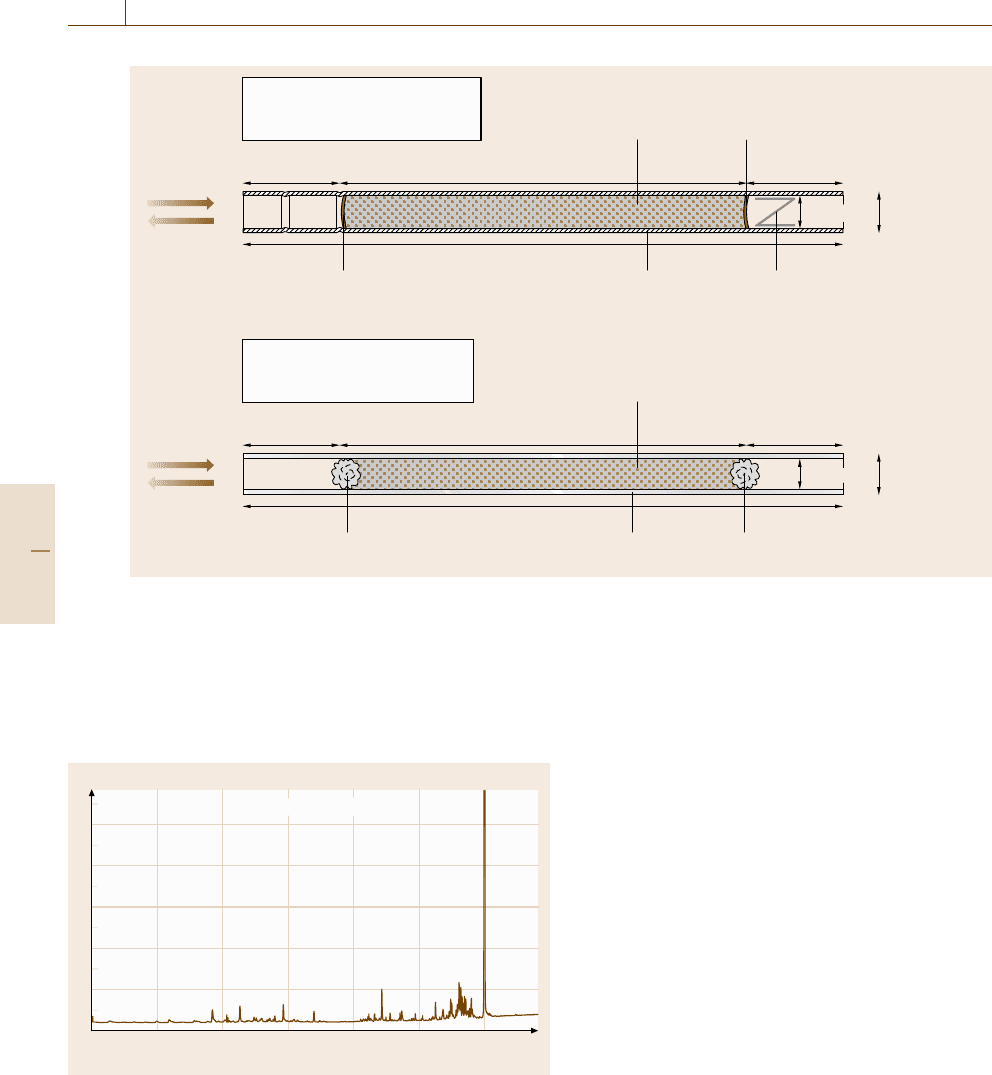
866 Part D Materials Performance Testing
Stainless steel tube:
Total volume: ~3 ml
Sorbent capacity: 200 –1000 mg
Pump flow
Desorb flow
Pump flow
Desorb flow
Glass tube:
Total volume: ~2 ml
Sorbent capacity: 130 –650 mg
Unsilanized
glass wool
Unsilanized
glass wool
Stainless steel
gauze (~100 mesh)
Stainless steel
gauze retaining spring
Stainless
steel tube
Glass tube
Stainless steel
gauze (~100 mesh)
15 mm Maximum 60 mm Minimum 15mm
15 mm Maximum 60 mm Minimum 15mm
3.5 inch (~89 mm)
3.5 inch (~89 mm)
5 mm I.D.
4 mm I.D.
¼ inch
(~ 6mm) O.D.
¼ inch
(~ 6mm) O.D.
Adsorbent
bed(s)
Adsorbent
bed(s)
Fig. 15.21 Example of the construction of commercially available adsorbent tubes for thermal desorption
28 d. All named substances are quantified by calibra-
tion using authentic standards. The unidentified VOCs
are quantified by toluene equivalents (according to
ISO 16000-6 [15.95]).
Abundance (× 10
6
)
5
4
3
2
1
0
0101520253035
Time
TIC: 1801002.D
12 3 4 56 7
8
Fig. 15.22 Chromatogram from the measurement of a PVC floor-
ing on the 28th day. 1: Methylisobutylketone (MIBK); 2: Decane;
3: Undecane; 4: Cyclodecane (internal standard); 5: Butyldiglykol;
6: n-methylpyrrolidone; 7: different VOCs; 8: 2,2,4-trimethyl-1,3-
pentanediol diisobutyrate (TXIB)
Calculation of Emission Rates
From the concentration of VOCsinthechamberair,
emission rates (ER) or specific emission rates (SER)
can be calculated. The most common for the expres-
sion of specific emission rates for materials is the area
specific emission rate (SER
a
) [15.84, 85], which is cal-
culated from the concentration C at a certain time (e.g.
3 d (72 h) or 28 d) according to
SER
a
=Cq = CnL
−1
, (15.3)
where SER
a
is the are specific emission rate at a certain
time [μgm
−2
h
−1
], C is the concentration at a certain
time [μgm
−3
], q is the area specific ventilation rate
[m
3
m
−2
h
−1
], n is the air exchange rate [h
−1
], L is the
product loading rate [m
2
m
−3
].
Specific emission rates can also be expressed as
length, volume or unit specific emission rates. Of-
ten specific emission rates are named emission factors
(EF) [15.83,87].
15.2.7 Time Behavior and Ageing
Time behavior of material emissions can also be eval-
uated by means of emission test chambers. After
introducing the test specimen into the chamber, 100% of
Part D 15.2
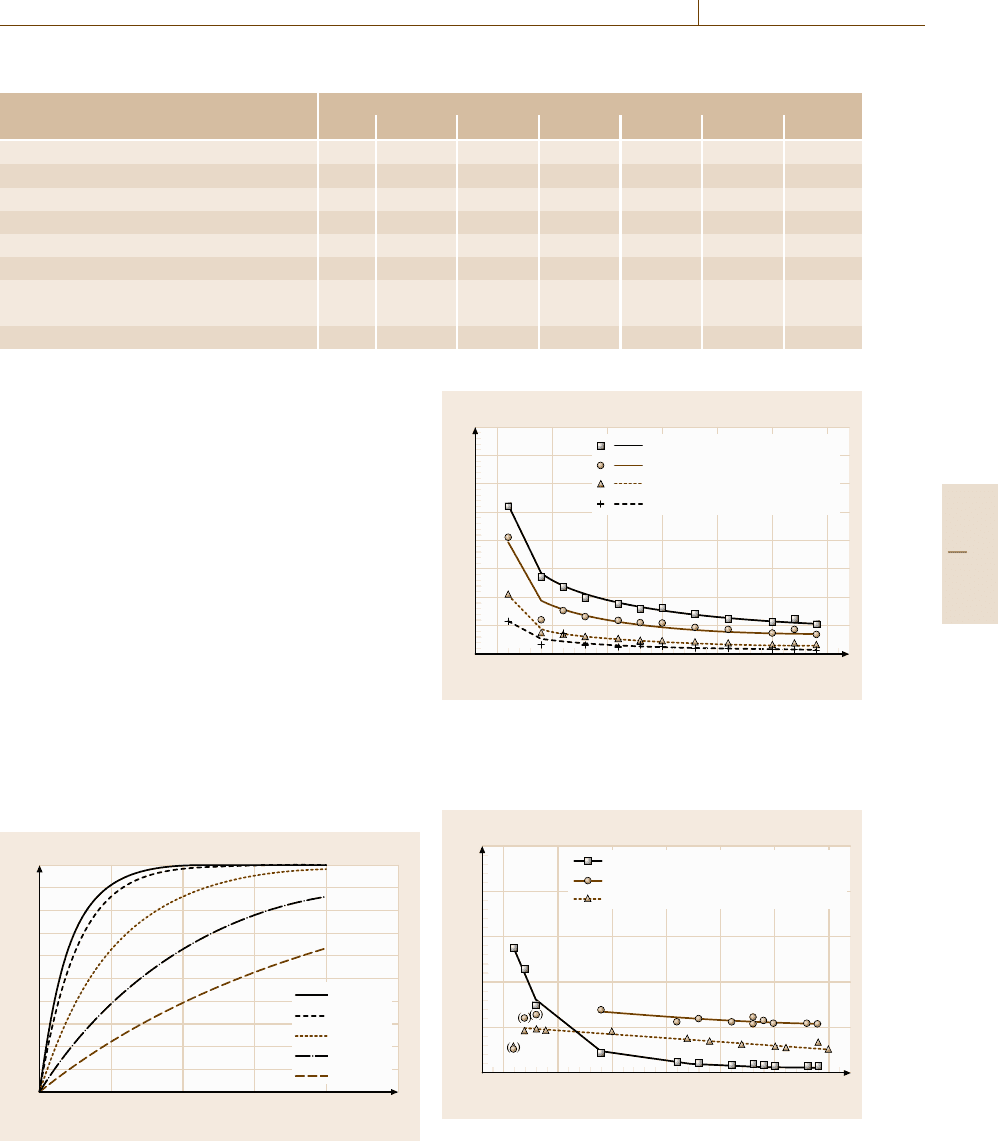
Material–Environment Interactions 15.2 Emissions from Materials 867
Table 15.9 List of emitted substances and their concentrations for PVC flooring for different times of testing
PVC Concentration (μg/m
3
)
24 h 3rd day 7th day 10th day 14th day 21st day 28th day
MIBK (methylisobutylketone) 111 65 53 45 39 32 30
Decane 55 35 28 25 23 20 16
Undecane 44 28 22 20 18 16 13
Butyldiglycol 123 75 40 48 44 35 31
N-Methylpyrrolidon 45 30 17 20 15 13 15
VOCs(n ≈ 23) 438 308 273 253 221 175 159
TXIB 1251 863 760 698 641 614 539
(2,2,4-trimethyl-1,3-pentandiol diisobutyrat)
TVOC 2067 1404 1193 1109 1001 905 803
the equilibrium concentration is usually reached within
a few hours for VOCs, depending on the air exchange
rate (Fig. 15.23); the concentration is given by
C = SER
a
(1 − e
−nt
)LV
−1
n
−1
, (15.4)
where V is the chamber volume [m
3
].
This increase of concentration at the beginning of
the emission test is mainly of interest if short-time emis-
sions are to be investigated, for example to study the
emissions from fast printing hard-copy devices (where
printing time is often less than half an hour) in or-
der to consider this for the calculation of emission
rates.
If the testing time is long enough at least a trend
for the variation of concentration or specific emission
rates over time can be evaluated. Typically measure-
ments in test chambers run over 28 d. VOCs during this
time usually show decreasing concentrations, as can be
Relative concentration (%)
100
90
80
70
60
50
40
30
20
10
0
0 0.5 1 1.5 2 2.5
Time (h)
n = 5.0h
–1
n = 4.0h
–1
n = 2.0h
–1
n = 1.0h
–1
n = 0.5h
–1
Fig. 15.23 Theoretical percent concentration profiles for
various air exchange rates
VOC concentration C (µg/m
3
)
80
70
60
50
40
30
20
10
0
0 5 10 15 20 25 30
Testing time t (d)
alpha-Pinene
delta-3-Carene C(28) = 7 µg/m
3
C(28) = 3µg/m
3
beta-Pinene
C(28) = 2µg/m
3
Limonene
C(28) = 11µg/m
3
Fig. 15.24 Terpene emissions from a particleboard over the
testing time of 29 days (T = 23
◦
C, RH =45%, n =1h
−1
,
L = 1m
2
m
−3
, q = 1m
3
m
−2
h
−1
)
VOC/SVOC concentration C (µg/m
3
)
0 5 10 15 20 25 30
Testing time t (d)
250
200
150
100
50
0
n-Butylacetate (boiling point: 127 °C)
Benzophenone (boiling point: 305 °C)
Diisobutylphthalate (boiling point: 327°C)
Fig. 15.25 Variation of concentration of a VOC and two
SVOCs over time. Notice the increase of concentration for
the SVOCs over the first few days
Part D 15.2
